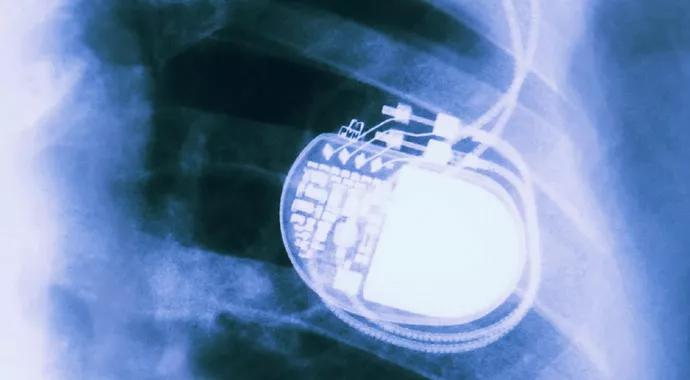New data show underuse in women despite superior outcomes


Niraj Varma, MD, PhD
Cleveland Clinic is a non-profit academic medical center. Advertising on our site helps support our mission. We do not endorse non-Cleveland Clinic products or services. Policy
Over the past decade, cardiology has been awakening to the fact that women are different from men. The latest case in point has just emerged over the past year: Women receive fewer implantable cardiac devices (ICDs) than men do, yet when women do receive these devices, their survival is the same or better than men’s.
What’s more, current guidelines for who should receive cardiac resynchronization therapy (CRT) — based on trials involving mostly male subjects — could be denying many women the chance to benefit.
“It’s astounding. These issues haven’t been examined properly because trials have enrolled few women,” says Cleveland Clinic heart rhythm specialist Niraj Varma, MD, PhD, whose pioneering work is now illuminating these gender differences.
Dr. Varma’s latest research, presented as a late-breaking trial at the European Heart Rhythm Association’s EUROPACE-CARDIOSTIM 2015 meeting in June, suggests that women make up only about one-third of patients referred for ICDs. But when women do receive ICDs, they survive as well as men overall, while those treated with cardiac resynchronization therapy (CRT) actually survive about 30 percent longer than men treated with CRT.
Those findings, from a retrospective database analysis of more than a quarter million patients who received various types of implantable cardiac devices from a single manufacturer, are likely to represent nationwide utilization patterns, Dr. Varma says.
It’s not clear why women are less likely to be referred, but some cardiologists and internists might have been influenced by older data suggesting that women do less well with ICDs. This new study differs in several ways:
Plus, its findings on women have now been backed up by other recent studies.
“I think this story is on its way to maturing, with some significant contributions in the last 12 months,” Dr. Varma notes.
Indeed, in a recent 10-year analysis of Cleveland Clinic’s database, Dr. Varma and colleagues examined the effect of CRT in 212 heart failure patients with left bundle branch block (LBBB) and nonischemic cardiomyopathy. Overall, response to therapy (defined as an increase in left ventricular ejection fraction) was significantly better in women. Importantly, this gender effect was even stronger among patients with QRS duration less than 150 msec, in whom response rates were 86 percent for women vs. just 36 percent for men.
Since current professional society guidelines limit the class I indication for CRT to patients with LBBB who have QRS duration of 150 msec or greater, many eligible women may be excluded from the treatment, Dr. Varma says.
His group’s paper was published in July 2014 in Heart Rhythm (and deemed one of the journal’s top papers of the year at the 2015 Heart Rhythm Society meeting). Its findings were supported by another paper published just a month later, in JAMA Internal Medicine. Investigators from the FDA published a meta-analysis from three large trials of CRT-defibrillator treatment in adults with mild heart failure showing similar findings: Among patients with LBBB and QRS duration of 130 to 149 msec, women had a 76 percent reduction in both heart failure and death, while men had no significant benefit in either.
The guidelines do give a class IIa indication to LBBB patients with QRS duration of 120 to 149 msec, but the new data suggest that the indication should be moved to class I for women to ensure that those who qualify are offered the treatment, Dr. Varma says.
The mechanisms behind the gender difference in CRT response aren’t clear, although there are many theories. Heart size and overall QRS duration are smaller in women than in men, but Dr. Varma doesn’t think size can explain the magnitude of the difference. “The kind of heart failure in women may be different,” he says. “Nobody has really looked at this.”
Guidelines may eventually change, but that typically takes a long time. Meanwhile, Cleveland Clinic now offers CRT to women with LBBB and QRS duration less than 150 msec.
After Dr. Varma presented his new data at the EUROPACE meeting, other cardiologists told him they would do so as well. “At the moment, change depends on people reading the medical literature and being convinced by others who have changed their practice,” he notes. “Word of mouth matters a lot.”

Surprise findings argue for caution about testosterone use in men at risk for fracture

Findings support emphasis on markers of frailty related to, but not dependent on, age
![GettyImages-1252287413 [Converted]](https://assets.clevelandclinic.org/transform/StoryPanel/350804b2-f1e4-4d97-a277-9629cf45af3e/23-HVI-4120348_redlining_650x450_jpg?w=3840&q=75)
Large database study reveals lingering health consequences of decades-old discrimination

Additional analyses of the two trials presented at 2023 ESC Congress

Prospective SPIRIT-HCM trial demonstrates broad gains over 12-month follow-up

An ACC committee issues recommendations to accelerate sluggish progress

Review of our recent experience shows it’s still a safe option

Machine learning may improve risk prediction and guide therapy